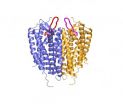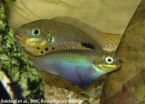(Press-News.org) STANFORD, Calif. - An alarming number of adolescents already battling eating disorders are also intentionally cutting themselves, and health-care providers may be failing to diagnose many instances of such self-injury, according to a new study from Stanford University School of Medicine and Lucile Packard Children's Hospital.
The researchers found that 40.8 percent of patients with eating disorders in their study had documented incidents of intentionally harming themselves, most often by cutting and burning. What's more, the study suggests that inadequate clinical screening might mean the count should be much higher.
"These are very high numbers, but they're still conservative estimates," said the study's lead author, Rebecka Peebles, MD, who was an instructor in pediatrics at Stanford when the research was conducted and is joining the faculty at Children's Hospital of Philadelphia.
Peebles noted that clinicians aren't routinely asking about this activity. "We ask 97 percent of children 12 years and up if they smoke cigarettes; we need to get that good with screening for self-injurious behavior," she said.
The study is to be published online Oct. 8 in the Journal of Adolescent Health. Its senior author is James Lock, MD, PhD, professor of psychiatry and behavioral sciences and of pediatrics. He is also psychiatric director of the Comprehensive Eating Disorders Program at Packard Children's Hospital.
To conduct the study, the researchers examined the intake evaluation records of 1,432 patients, ages 10-21, who were admitted to the hospital's eating disorders program from January 1997 through April 2008. Just over 90 percent of all the patients were female, three-quarters of them white, with a mean age of 15. Among the 40.8 percent identified to be physically harming themselves, the mean age was 16. Many of these patients had a history of binging and purging, and 85.2 percent of the self-injurers were cutting themselves.
The researchers also discovered that slightly fewer than half the charts showed that health-care providers had asked patients if they intentionally injured themselves. If patients aren't asked, they are unlikely to volunteer such information, said Peebles.
Those who were questioned tended to fit previously published profiles of a self-injurer: older, white, female, suffering from bulimia nervosa, or with a history of substance abuse. "The question is, 'Are we missing other kids who are not meeting this profile?'" Peebles said. "This is part of why we wanted to look at this. If you see an innocent-looking 12-year-old boy, you don't even think of asking about self-injurious behavior. We need to get much better about universal screening."
Peebles noted that the profile itself might be flawed. If health-care workers only ask a certain type of patient about a behavior, the profile that emerges will necessarily reflect that bias, she said.
The study did not examine the reasons behind such acts but Peebles said her clinical experience suggested patients "are trying to feel pain."
"Patients describe a feeling of release that comes when they cut or burn themselves," she said. "They'll cut with a razor or a scissor blade. Sometimes we've even had kids who will take the tip of a paper clip and gouge holes. To burn themselves, they'll heat up a metal object and press it to their skin, or they'll use cigarettes."
Physicians and other health-care providers at Packard's Comprehensive Eating Disorders Program now question all new patients about self-injurious behavior. Studies have shown that between 13 and 40 percent of all adolescents engage in some form of self-injury, which is also associated with a higher risk of suicide.
"In clinical practice, kids are fairly open when you engage with them," Peebles said. "They'll come in wearing long sleeves, or hiding the marks on their inner thighs. But then when you ask them, they are usually willing to discuss the behavior."
###
The study's other author is Jenny Wilson, MD, who was a resident in pediatrics when the study was conducted.
The study was funded in part by the Stanford Child Health Research Program. Information about the Departments of Pediatrics and of Psychiatry and Behavioral Sciences, which also helped to support this study, is available at http://pediatrics.stanford.edu and http://psychiatry.stanford.edu/.
The Stanford University School of Medicine consistently ranks among the nation's top medical schools, integrating research, medical education, patient care and community service. For more news about the school, please visit http://mednews.stanford.edu. The medical school is part of Stanford Medicine, which includes Stanford Hospital & Clinics and Lucile Packard Children's Hospital. For information about all three, please visit http://stanfordmedicine.org/about/news.html.
Ranked as one of the best pediatric hospitals in the nation by U.S. News & World Report, Lucile Packard Children's Hospital at Stanford is a 311-bed hospital devoted to the care of children and expectant mothers. Providing pediatric and obstetric medical and surgical services and associated with the Stanford University School of Medicine, Packard Children's offers patients locally, regionally and nationally the full range of health-care programs and services - from preventive and routine care to the diagnosis and treatment of serious illness and injury. For more information, visit http://www.lpch.org.
Note to all reporters: Due to a change in the online publication of the research referenced below, the embargo information has changed. Please disregard the version that we distributed on Sept. 23 and use this version instead. The embargo will lift at 9 p.m. Pacific time on Oct. 7.
09/24/10
EMBARGOED FOR RELEASE UNTIL: Thursday, Oct. 7, 2010, at 9 p.m. Pacific time to coincide with online publication in the Journal of Adolescent Health
PRINT MEDIA CONTACT: Erin Digitale at (650) 724-9175 (digitale@stanford.edu)
BROADCAST MEDIA CONTACT: Robert Dicks at (650) 497-8364 (rdicks@lpch.org)
Transgenic corn's resistance to pests has benefitted even non-transgenic corn, a new study led by scientists from the University of Minnesota shows.
The study, published in the Oct. 8 edition of the journal Science, found that widespread planting of genetically modified Bt corn throughout the Upper Midwest has suppressed populations of the European corn borer, historically one of corn's primary pests. This areawide suppression has dramatically reduced the estimated $1 billion in annual losses caused by the European corn borer, even on non-genetically modified corn. Bt ...
LA JOLLA, CA – October 4, 2010 – Researchers have determined the structure of a protein that helps guide blood-forming stem cells, or hematopoetic stem cells. The protein is also one of the main receptors used by the human immunodeficiency virus (HIV) to get inside blood cells.
The findings are described in the October 7, 2010 issue of the journal Science.
The structure offers a detailed view of how the cell surface receptor, called CXCR4, interacts with molecules outside the cell. The results have implications for developing new drugs for hematopoetic stem cell transplantation, ...
VIDEO:
This model shows how HIV, in gray, might latch on to immune cell receptor molecules, allowing the virus to enter and infect the cell. The viral protein, gp120, shown in...
Click here for more information.
In a technical tour de force, structural biologists funded by the National Institutes of Health have determined the three-dimensional structure of a molecule involved in HIV infection and in many forms of cancer. The high-resolution structure sheds light on how the ...
Washington, DC/Beijing, China (7-8 October 2010)—A new study released today in Washington, DC and Beijing suggests that one of the world's largest and "greenest" paper companies, in concert with local officials and other middlemen, used illegal means to gain control over thousands of hectares of Chinese forestlands, with a goal of acquiring 120 thousand hectares for a eucalyptus plantation in the Guangxi Autonomous Region of southern China.
The authors say their research shows that the middlemen, acting on behalf of Finnish paper and pulp manufacturer Stora Enso, often ...
For the first time, biologists have described the evolution of the size of a female trait which males use to choose a partner. The research, published in the open access journal BMC Evolutionary Biology, shows that male cichlid fish prefer females with a larger pelvic fin and that this drives females to grow fins out of proportion with their body size.
Sebastian Baldauf from the University of Bonn, Germany, worked with a team of researchers to study the effects of female ornamentation in the African cichlid fish Pelvicachromis taeniatus. He said, "In contrast to the ...
Ultrasound can speed the healing of fractures. A randomized controlled trial reported in the open access journal BMC Musculoskeletal Disorders has found that the use of low-intensity pulsed ultrasound (LIPUS) in patients with tibial fractures which showed inadequate progress toward healing resulted in 34% greater bone mineral density (BMD) in the fracture area after 16 weeks than use of a sham device.
Jon E. Block, Ph.D. worked with a team of researchers from University Hospital Marburg and the University of Ulm, Germany, to test LIPUS in 51 patients and 50 controls. ...
Scientists from the Max Planck Institute for Chemical Ecology in Jena, Germany, have solved a case of fraud that has been pending for 40 million years. Arum palaestinum, also called the Solomon's lily, attracts drosophilids (vinegar flies) as pollinators by emitting odor molecules that resemble those produced during alcoholic fermentation of rotting fruit initiated by yeast. The plant accomplishes the illusion of yeast simply by producing six chemicals that - together in a specific mix - create the impression of fermentation in the fly brain. The produced volatiles include ...
The Georgia Tech Information Security Center (GTISC), a national leader in information security research and education, today announced the release of the GTISC Emerging Cyber Threats Report for 2011, outlining the top three areas of security risk and concern for consumer and business Internet and computer users. The report was released today at the annual GTISC Security Summit on the Evolving Nature of Cyber Security Threats. The summit gathers leading industry and academic leaders who have distinguished themselves in the field of cyber security.
According to the report, ...
MADISON – Widespread planting of genetically modified Bt corn throughout the Upper Midwest has suppressed populations of the European corn borer, a major insect pest of corn, with the majority of the economic benefits going to growers who do not plant Bt corn, reports a multistate team of scientists in the Oct. 8 edition of the journal Science.
In Wisconsin, 75 percent of the $325 million cumulative economic benefit linked to Bt corn's pest suppression between 1996-2009 went to non-Bt corn growers. Wisconsin currently has about 3.9 million corn acres, with approximately ...
A low Apgar score at birth is strongly associated with cerebral palsy in childhood, concludes a study from researchers in Norway published on bmj.com today.
The Apgar score is a quick and simple way to assess a baby's condition at birth. The baby is assessed on five simple criteria (complexion, pulse rate, reaction when stimulated, muscle tone, and breathing) on a scale from zero to two. The five values are then summed up to obtain a score from zero to 10.
Scores of 3 and below are generally regarded as critically low, 4 to 6 fairly low, and 7 to 10 generally normal.
Cerebral ...


